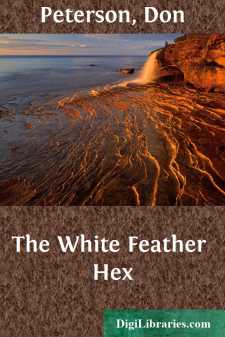Categories
- Antiques & Collectibles 13
- Architecture 36
- Art 48
- Bibles 22
- Biography & Autobiography 813
- Body, Mind & Spirit 141
- Business & Economics 28
- Children's Books 12
- Children's Fiction 9
- Computers 4
- Cooking 94
- Crafts & Hobbies 4
- Drama 346
- Education 46
- Family & Relationships 57
- Fiction 11826
- Games 19
- Gardening 17
- Health & Fitness 34
- History 1377
- House & Home 1
- Humor 147
- Juvenile Fiction 1873
- Juvenile Nonfiction 202
- Language Arts & Disciplines 88
- Law 16
- Literary Collections 686
- Literary Criticism 179
- Mathematics 13
- Medical 41
- Music 40
- Nature 179
- Non-Classifiable 1768
- Performing Arts 7
- Periodicals 1453
- Philosophy 64
- Photography 2
- Poetry 896
- Political Science 203
- Psychology 42
- Reference 154
- Religion 513
- Science 126
- Self-Help 83
- Social Science 81
- Sports & Recreation 34
- Study Aids 3
- Technology & Engineering 59
- Transportation 23
- Travel 463
- True Crime 29
The White Feather Hex
by: Don Peterson
Description:
Excerpt
It all started with a Dutchman, a Pennsylvania Dutchman named Peter Scheinberger, who tilled a weather beaten farm back in the hills.
A strong, wiry man he was—his arms were knotted sections of solid hickory forming themselves into gnarled hands and twisted stubs of fingers. His furrowed brow, dried by the sun and cracked in a million places by the wind was well irrigated by long rivulets of sweat. When he went forth in the fields behind his horse and plow, it wasn't long before his hair was plastered down firmly to his scalp. The salty water poured out of the deep rings in his ruddy neck and ran down his dark brown back. As he grew older the skin peeled and grew loose. It hung on him in folds like the brittle hide of a rhino.
It seemed that the more years he spent in his fields behind the plow horse, the more he slipped back into the timeless tradition of his forefathers. He was a proud descendant of a long line of staunch German settlers commonly known as the Pennsylvania Dutch. He grew up in his fundamental, religious sect having never known any other environment. He was exposed to the sun, soil, and wind from the early days of his childhood, and along with the elements he also was exposed to the evils of the hexerei. The hexerei, or witchcraft, was something that was never doubted or scoffed at by his people. Then why should he, a good Pennsylvania Dutchman, doubt or scoff at such tradition?
Perhaps, had he moved away from his ancestral lands and had been cultured in modern communities, been educated and raised in other schools, he might have matured. But having no time for any other diversions than might be found on his rustic homestead, he grew up behind the plow horse, tramping in the dark, stony pasture land, eking out his meager existence from the black fields of Pennsylvania.
Now, Peter's life could have gone on unnoticed among these forgotten hills, except for the strange visit of Martin G. Mirestone, student of German history.
It was a cold night when Peter met Mirestone. Peter had been sitting up rather late pondering over an old, yellowed book by the light of a kerosene lamp. The pale flame flickered about the walls sending shadows scurrying back and forth creating all types of weird shapes and designs. Peter huddled over the withered pages, every now and then glancing up at the walls to watch the fantastic games that light and dark were playing. Then putting his book aside for the night he prepared to go to bed.
He went over to the window to draw the shutters, stopping for an instant to peer out into the gloom along the stony path that ran from his house to an old foot-bridge about fifty feet away. Curling up from the gorge, mist seemed to play among the rotted planks; it rose and fell in great billowing blankets, sometimes concealing the structure from view.
Peter was about to latch the shutter and leave when his attention was focused upon a figure that seemed to emerge from the fog—sort of fading in from nowhere. It made its way across the narrow span like some ghostly apparition. The mist enveloped his legs and clouded his features. Peter drew back in terror, for the mere appearance of the man coming out of the darkness was enough to fill his infant brain with visions of death and hexerei....


